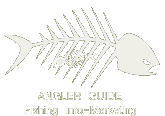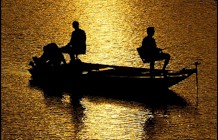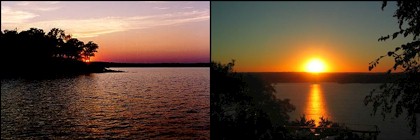Lake Arrowhead
is recognized as a premier white crappie lake. Be prepared to share the
water with many other anglers in spring, when limits of nice-size crappie are
caught in the lower half of the reservoir. Arrowhead also contains channel,
blue, and flathead catfish, with channel cats being most harvested.
All three species can get big here: the lake record for channel catfish is 12.8
pounds, and for blues, 38 pounds. Flatheads over 40 pounds are not uncommon; the
record here is 56.8 pounds. Largemouth bass fishing can be very good at times,
depending on water turbidity. Bass of the Florida largemouth strain were stocked
in 1990, 1995, and 2001. There have been documented catches of largemouth bass
over nine pounds, and tournaments are becoming increasingly popular. Abundant
numbers of large, hungry, white bass cruise the lake throughout the year.
The lake record is 2.77 pounds.
Tips & Tactics
Spring is the time to fish for white crappie. While crappie
can be caught year round, the majority are caught during the spawning period.
They'll be located in shallow water around the shorelines. The dam, state park
area, and bridges produce strings full of fish. Skirted crappie jigs or minnows
are baits of choice. At other times of year, crappie will be found around state
park piers and docks that have brush piles under them. Boat anglers can almost
always catch crappie at the oil derricks.
Nice-sized largemouth bass can be found in the lower parts
of the reservoir, concentrated around rock riprap, aquatic vegetation, docks,
points, and woody debris. Most are caught near the state park cove, the dam, and
the Henrietta bridge. Topwater and shad imitation baits work well, especially
during the summer months. As a rule, bass at Arrowhead are found in water five
feet deep or less. If the water is somewhat muddy, they may be found in water
only 1-2 feet deep.
Fishing for catfish is most productive in the warm months,
March through November. Favorite baits include shrimp, prepared stinkbaits, and
shad. Boat anglers have had high success rates "baiting out" likely areas with
soured wheat. This usually attracts channel cats within a day and can provide
good fishing for several days. Another productive technique is drift fishing. On
days with light to moderate winds, boat anglers bait multiple rods with shrimp
or shad and let the boat drift with the wind, keeping bait near the bottom.
While there is not a well-defined white bass spring spawning
run, groups of mature fish do congregate off most of the rocky main lake points
in March and April. These fish run up to three pounds, and their holding points
can be easily located with depth finders. As the water warms in late spring and
summer, schooling fish spend most of their time in the lower part of the
reservoir chasing schools of shad. At this time, shad imitation lures work well
cast toward shore or trolled. Trolling boat anglers may want to stop and anchor
when they locate actively feeding white bass.
Location:
15 miles southeast of Wichita Falls off US Highway 281
Size:
16,200 acres
Maximum Depth:
45 feet
Date Impounded:
1966
Normal Water Clarity:
1-2 foot visibility
Water Level Fluctuation:
4-6 feet
Conservation Pool
Elevation: 926 ft. msl
Current Water Levels
Aquatic Vegetation:
Limited primarily to floating mats of American pondweed located around the state
park and nearby coves, and some reeds when lake is at normal elevations. Due to
fluctuating water levels and periodic high turbidity, there are periods with no
vegetation.





